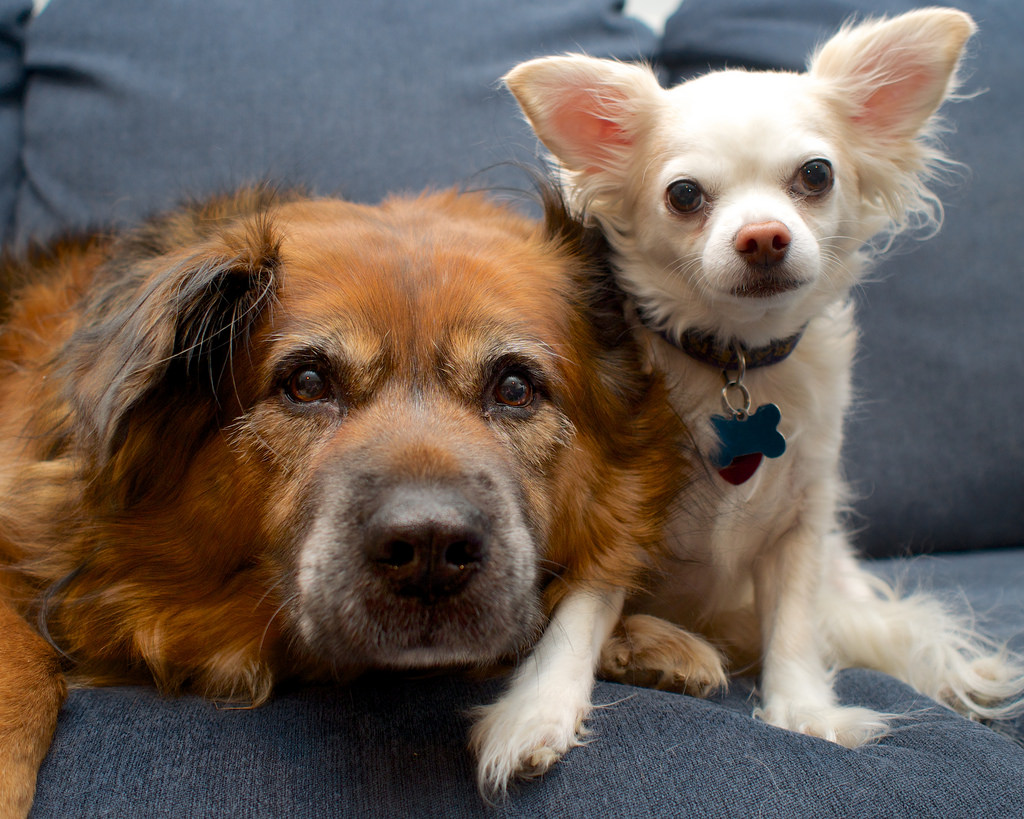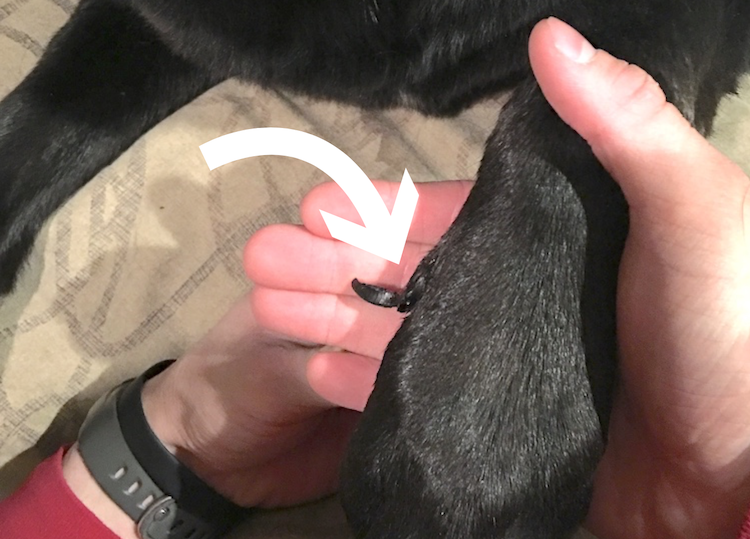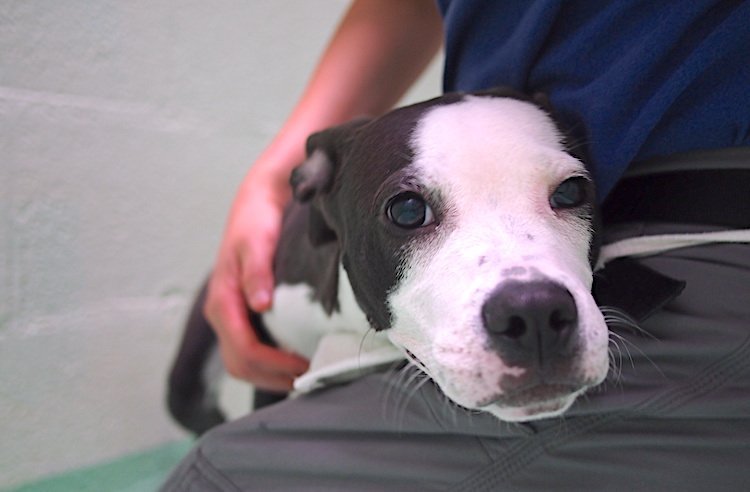Elbow Dysplasia in Dogs: How We Diagnose and Treat It
Most dogs with elbow dysplasia have a long-term limp in a front leg. Learn much more about the symptoms, causes and treatment in this article.

On my journey to work, I pass a young chocolate Labrador Retriever who limps on her left front leg.
Because she is a Lab, statistically the odds are that she has elbow dysplasia.
This condition is the most common cause of lameness in young, large or giant breeds of dog.
The word “dysplasia” means an abnormality of growth.
With respect to the elbow, this means the bones don’t fit together correctly. If you have a young, large-breed dog who has intermittent foreleg lameness, then you need to know about elbow dysplasia.
Elbow dysplasia is the most common cause of foreleg lameness in young dogs and can lead to premature arthritis, which then negatively affects the dog’s enjoyment of life. Getting the problem sorted out early could prevent this from happening.
Here are some important facts to know.
Don’t Guess When It Comes To Your Pet’s Care


Don’t Guess When It Comes To Your Pet’s Care
What Is Elbow Dysplasia?
This is an umbrella term for several anatomical problems that affect the elbow, a complex joint that comprises 3 bones that must mesh together perfectly to form a pain-free hinge: humerus (upper arm), radius and ulna (forearm).
These bones all slot together in a 3D puzzle.
However, if one of the bones is a bit short, or the shape is wrong, the result is abnormal strain on the elbow, which causes pain and therefore lameness.
Common reasons for elbow dysplasia in dogs:
- One bone grows too slow or too fast
- Badly shaped bones
- Abnormal loading on the joint
- Micro fractures beneath the joint surface
- Chips of bone break off from the joint surface
Unfortunately, the condition gets steadily worse over time as the damage and inflammation worsen the joint’s ability to hinge smoothly and without pain.

Symptoms of Elbow Dysplasia in Dogs
As with my Lab, the typical sign is a young dog with foreleg lameness.
Does your dog’s head bob up and down as they walk? If so, your dog has foreleg lameness. This may have nothing to do with his elbow (he may just have a splinter in his paw), but if the lameness persists, tell your veterinarian.
To discover which leg or legs hurt, watch your dog’s head as it bobs up and down. The head goes “down on the sound” leg, or rather, it jerks up when the sore leg takes her weight.
However, not all dogs with elbow dysplasia are lame all the time, in which case they tend to be most stiff after rest and can run the lameness off.
Most dogs with elbow dysplasia have a long-term limp in a front leg. Often they can fetch and are full of life, but they either are limp or stiff when getting out of bed.
Your vet’s suspicions are raised if the dog has pain in the elbow when the leg moves in a certain way.
To investigate, the vet may X-ray the leg, but in the early stages of dysplasia the results are often inconclusive. This is because X-rays are not sensitive enough to pick up micro fractures or show damage to the joint surface.
The gold standard tests are an MRI or a CT scan and endoscopy of the joint. These give a full picture of the bone and joint surface, which helps clinicians advise whether surgery could help or if medical therapy is the best way forward.

Causes
Elbow dysplasia is genetic and transferred from parents to puppies. Experts believe there are more than 100 genes that code for elbow development, and it takes only 1 error to place a dog at risk.
Because there are more than 100 gene codes for this, there is plenty of scope for error — some breeds have more than their fair share. This means elbow dysplasia is a complex condition.
The most common development problems include:
- Osteochondritis dissecans (OCD): The joint’s cartilage lining flakes away and causes pain.
- Fragmented coronoid process (FCP): A tiny spur of bone breaks loose and moves when tendons pull on it.
- Un-united anconeal process (UAP): A piece of bone designed to stabilize the elbow doesn’t fuse properly and moves as the joint flexes and extends.
Gene coding errors can mean bones grow at different rates. This places greater stress on certain pressure points, which can lead to microfractures.
The latest thinking is that some of the cartilage problems associated with elbow dysplasia in dogs are actually the result of microfractures in the underlying bone.
Not all dogs with a gene coding for elbow dysplasia go on to develop disease. Some are just unlucky, while others have a helping hand to push them over the edge.
Risk factors include:
- Being overweight as a puppy: Carrying extra weight places a strain on the elbows.
- Too much exercise: Over-strenuous or over-tiring exercise while the bones are still developing can cause damage, such as chipped cartilage or microfractures.
- Growing too rapidly: Feeding an over-rich diet that forces the puppy to grow too big too quickly can damage the joints.
Plenty of dogs develop elbow dysplasia who were slim puppies and exercised sensibly. Sometimes things are just beyond our control.
Diagnosis
How the dog reacts when their elbow is moved in certain directions can be suggestive of elbow dysplasia.
Radiographs help confirm the diagnosis, but they can miss subtler changes. Modern techniques, such as CT scans, pick up much more detail, including tiny stress fractures and minor displacements.
Another useful tool is arthroscopy, where a tiny camera is inserted into a keyhole incision to get a panoramic view of the joint surfaces.
Treatment
A veterinarian must accurately diagnose the condition first to find which part of the elbow is faulty — then the vet can decide if surgery is an option. Many of the problems causing elbow dysplasia have specific operations that may make a difference.
Is surgery absolutely required for elbow dysplasia in a dog?
No, not always. Mild cases can be managed with physiotherapy, weight control and use of painkillers.
However, if the underlying anatomical defect is not fixed, the dog is more likely to develop arthritis later.
What if my dog is severely lame?
If the dog is severely lame, then referral to an orthopedic specialist is advisable. In the hands of a skilled surgeon, corrective surgery carries every chance of success.
What if surgery is not an option?
If surgery isn’t an option, the following treatment may be appropriate for elbow dysplasia:
- Weight management: Slimming down sometimes makes a big difference so the elbows then carry less weight.
- Pain relief: Painkillers from the NSAID (non-steroidal anti-inflammatory drugs) group are effective and have a good safety profile.
- Physiotherapy: Methods such as physiotherapy, massage and hydrotherapy help keep the joint supple and strengthen the supporting muscles.
- New therapies: These include emerging techniques such as stem cell therapy or platelet rich plasma, which show promise.
Prevention
Elbow dysplasia is a genetic condition. Ultimately, reducing the risk of elbow dysplasia lies in the hands of breeders working in cooperation with screening programs to eliminate the condition.
Current practice involves taking radiographs of the elbows of the mother and father and breeding only from dogs with healthy elbows. Even this isn’t foolproof — some dogs have great elbows on an X-ray, but can carry faulty genes that show up in their puppies.
Responsible breeding will go a long way to reduce the incidence of elbow dysplasia. Of course, screening parents isn’t usually possible with stray or adopted dogs.
If you have a large or giant breed puppy, keep them lean in their first year of life. This helps reduce the load on the bones at a time when the dog is still growing and developing. Once the bones have matured, they are hardier and less vulnerable to damage from ordinary wear and tear.
And if you notice the symptoms of elbow dysplasia in your dog, check with your vet to determine what treatment is needed, if any.
References
- A Guide to Canine and Feline Orthopedics. Denny & Butterworth. Publisher: Wiley-Blackwell. 4th edition.
 This pet health content was written by a veterinarian, Dr. Pippa Elliott, BVMS, MRCVS. It was last reviewed Nov. 2, 2018.
This pet health content was written by a veterinarian, Dr. Pippa Elliott, BVMS, MRCVS. It was last reviewed Nov. 2, 2018.






